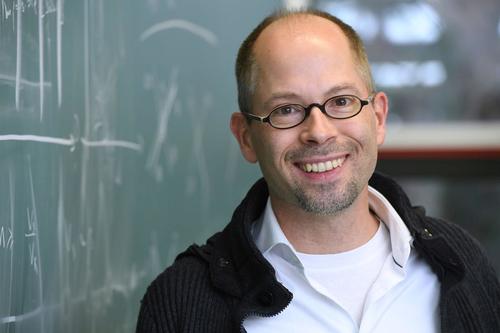Official Certification for Technology of the Future
A project spearheaded by physicist Jens Eisert is part of a European flagship program, which has received about one billion euros in funding.
Mar 15, 2019
Physicists like Jens Eisert aim to build quantum simulators that help to simulate and decipher highly complex physical phenomena.
Image Credit: privat
Jens Eisert believed in quantum computers even before the media had taken note of this kind of ultrafast computers.
Now a professor of physics at the Dahlem Center for Complex Quantum Systems at Freie Universität Berlin, Eisert spent weeks reading specialized literature on the subject to familiarize himself with what was then the new field of quantum information processing. He says he was “really keen” to learn about how the strange laws of quantum physics could be harnessed for new information technologies.
Thanks to quantum physics, there are already encryption methods that are safe from eavesdropping. It might not be long before there are also quantum simulators, or even quantum computers that outperform even the fastest conventional supercomputers in terms of processing speed for certain applications. That would make it possible to solve certain problems that even today’s supercomputers can’t crack.
Eisert is working toward that goal with other leaders in quantum information processing, such as Immanuel Bloch of the Max Planck Institute of Quantum Optics in Garching and Rainer Blatt of the University of Innsbruck. The Berlin team headed by Eisert (48) is among the few consortia to have received funding from the European Union as part of a flagship program in quantum technology.
The program has a budget of about one billion euros in all. Quantum physicists like Bloch, Blatt, and Eisert are united by a single vision: to build computers and quantum simulators that simulate highly complex and potentially highly useful phenomena in physics and thus help to decipher them. High-temperature superconductors, for example, are among the biggest challenges faced by physicists. These are solids that still have to be cooled to far below freezing in order for them to conduct electricity without any loss, but not as far as normal superconductors. The scientists hope that if they could understand how high-temperature superconductors work at the atomic and subatomic level, it would be possible to manufacture electrical conductors that conduct electricity without loss even at normal temperatures. That could revolutionize transportation or the energy supply, for example, when it comes to transporting electricity over long distances.
Like engineers who test the aerodynamics of a new vehicle body via computer simulations, physicists are now trying to model crystals and other solids, atom by atom, in a simulator to understand the complex interactions between a large number of atoms and electrons that lead to phenomena like high-temperature superconductivity.
But conventional computers can only do this to a very limited extent. These computers operate according to the laws of traditional physics, and those laws only allow an electronic switch to exist in one state: on or off. However, tiny particles such as atoms, electrons, or photons follow the laws of quantum physics instead. They can lead parallel existences, in a way, rotating both counterclockwise and clockwise simultaneously or taking on two energy states at once. A traditional computer that tries to simulate phenomena like these has to take every single possibility into account. The difficulty is that every additional particle doesn’t just mean one more possibility, but rather multiple possibilities. Molecules or solid models with more than about 50 particles are therefore impossible to simulate in full, even with the most powerful supercomputers currently in existence.
Richard Feynman, an American physicist and Nobel laureate, had a brilliant idea in the 1980s: Why not build the computer itself out of atoms or other quantum particles? Then it would work according to the laws of quantum physics itself, and it could process possibilities at the same time without the need for storage getting out of control. And with that, the idea of the quantum simulator was born. In the meantime, physicists are able to use laser light to arrange individual atoms into regular grids like eggs in an egg carton and control their interactions, thereby simulating simple molecules or solids.
They are now working to enlarge these kinds of simple quantum simulators and make them more powerful in order to simulate complex systems that are too much for a traditional computer to handle. But quantum simulations can’t perform just any calculations. Each one is specially “tailored” to the problem it is intended to solve. Eisert’s role is to provide theoretic bases for this, “always in very close coordination with the experimental physicists,” as he adds. Eisert’s team is exploring what quantum simulators can do. For example, his researchers have shown that a quantum simulator can make certain statements about dynamic and disorganized systems of particles in a shorter time than a supercomputer can today.
The physicists in Berlin are also working on the question of whether the results achieved by a quantum simulator can be trusted. Their goal is a kind of certification for quantum simulators. That’s a tall order, since the quantum state of a particle or system cannot be observed without altering it. As a result, the computing process itself is hidden behind a kind of veil. For a long time, scientists assumed that meant that only results that can also be achieved by a traditional computer could be checked. But Eisert’s team has shown that even in the case of more complex calculations that a traditional computer cannot manage, it is possible to take a number of measurements and check to make sure the quantum simulator is working properly.
Certification is one of the challenges that the flagship program aims to solve. With the quantum physicists in Berlin on the team, it should be possible.
Further Information
Prof. Dr. Jens Eisert, Department of Physics, Freie Universität Berlin, Tel.: +49 30 838 55531, Email: Prof. Dr. Jens Eisert

